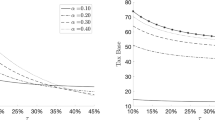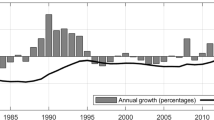Abstract
We study whether tax considerations are an important determinant of commercial mortgage default. We also study whether large lenders are better informed, or better at interpreting information for lending purposes, and hence have lower foreclosure rates; whether lenders have more information on larger borrowers than smaller borrowers, and hence have lower foreclosure rates on larger loans; and whether commercial mortgage defaults are related to debt service coverage and loan-to-values, both initial and contemporaneous. The paper’s main findings are fourfold. First, holding all else equal, there is evidence that tax considerations influence investors’ decisions about when to “put” assets to lenders. The results are consistent with the argument of Constantinides (J Financ Econ 13:65–89, 1984). Second, the evidence suggests that large lenders are especially knowledgeable about commercial mortgage borrowers and commercial property markets, in that they have lower foreclosure rates than smaller lenders. Third, on the question of whether lenders have more information on larger borrowers than smaller borrowers, we find that larger loans have, on average, lower default rates than smaller loans. Fourth, the findings suggest that lower default rates are associated with higher debt service coverage ratios, both initial and contemporaneous.
Similar content being viewed by others
Notes
In principle we could also study residential mortgage default to determine whether tax considerations influence the decision to default. However, as a part of the Mortgage Forgiveness Debt Relief Act of 2007, Congress enacted legislation that temporarily created a three-year window for homeowners to refinance their mortgage and pay no taxes on any debt forgiveness that they receive. Hence, the residential mortgage default decision should be largely independent and unaffected by tax considerations.
References
Ambrose, B. W., & Sanders, A. (2003). Commercial mortgage backed securities: Prepayment and default. Journal of Real Estate Finance and Economics, 26, 175–192.
Archer, W. R., Elmer, P. J., Harrison, D. M., & Ling, D. C. (2002). Determinants of multifamily mortgage default rates: Evidence from FDIC mortgage pools. Real Estate Economics, 30, 445–473.
Barber, B., & Odean, T. (2000). Trading is hazardous to your wealth: The common stock investment performance of individual investors. Journal of Finance, 55, 773–806.
Barber, B., & Odean, T. (2004). Are individual investors tax savvy? Evidence from retail and discount brokerage accounts. Journal of Public Economics, 88, 419–442.
Bester, H. (1985). Screening vs. rationing in credit markets with imperfect information. American Economic Review, 75, 850–855.
Brown, D. T., Ciochetti, B. A., & Riddiough, T. J. (2006). Theory and evidence on the resolution of financial distress. Review of Financial Studies, 19, 1357–1397.
Ciochetti, B. A. (1997). Loss characteristics associated with commercial mortgage foreclosure. Real Estate Finance, 14, 53–69.
Ciochetti, B. A., Deng, Y., Gao, B., & Yao, R. (2002a). The termination of commercial mortgage contracts through prepayment and default: A proportional hazard approach with competing risks. Real Estate Economics, 30, 595–633.
Ciochetti, B. A., Lee, G., Shilling, J. D., & Yao, R. (2002b). A proportional hazards model of commercial mortgage default with originator bias. Journal of Real Estate Finance and Economics, 22, 100–115.
Ciochetti, B. A., & Shilling, J. D. (2007). Loss recoveries, realized excess returns, and credit rationing in the commercial mortgage market. Journal of Real Estate Finance and Economics, 34, 425–445.
Constantinides, G. (1984). Optimal stock trading with personal taxes. Journal of Financial Economics, 13, 65–89.
Cornell, B., Longstaff, F. A., & Schwartz, E. S. (1996). Throwing good money after bad? Cash infusions and distressed real estate. Real Estate Economics, 24, 23–41.
Curry, T., Blalock, J., & Cole, R. (1991). Recoveries of distressed real estate and the efficiency of public vs. private management. Journal of the American Real Estate and Urban Economics Association, 19, 495–515.
Dammon, R., Dunn, K., & Spatt, C. (1989). A reexamination of the value of tax options. Review of Financial Studies, 2, 341–372.
Dammon, R., & Spatt, C. (1996). The optimal trading and pricing of securities with asymmetric capital gains taxes and transaction costs. Review of Financial Studies, 9, 921–952.
De Long, J. B., Shleifer, A., Summers, L. H., & Waldman, R. J. (1991). The survival of noise traders in financial markets. Journal of Business, 64, 1–20.
Downs, A. (1991). What have we learned from the 1980s experience? Salomon Brothers, Real Estate Research.
Episcopos, A., Pericli, A., & Hu, J. (1998). Commercial mortgage default: A comparison of logit with radial basis function networks. Journal of Real Estate Finance and Economics, 17, 163–178.
Esaki, H., Heureux, S. L., & Snyderman, M. (1999). Commercial mortgage defaults: An update. Working paper, Morgan Stanley Dean Witter.
Estrella, A., Gikas, A., & Hardouvelis, G. A. (1991). The term structure as a predictor of real economic activity. Journal of Finance, 46, 555–576.
Follain, J. R., & Ondrich, J. (1999). Stay, pay, or walk away: A hazard analysis of FHA-insured multifamily mortgage terminations. Working paper.
Goldberg, L., & Capone, C. A. (1999). Multifamily mortgage credit risk: Lessons from recent history. Cityscape: A Journal of Housing and Urban Development, 4, 93–113.
Grinblatt, M., & Keloharju, M. (2001). What makes investors trade? Journal of Finance, 56, 589–616.
Grinblatt, M., & Moskowitz, T. (2004). Predicting stock price movements from past returns: The role of consistency and tax loss selling. Journal of Financial Economics, 71, 541–579.
Harrison, D. M., Noordewier, T. G., & Yavas, A. (2004). Do riskier borrowers borrow more? Real Estate Economics, 385–412.
Kau, J. B., & Kim, T. (1994). Waiting to default: The value of delay. Journal of the American Real Estate and Urban Economics Association, 22, 539–551.
Laurent, R. D. (1988). An interest rate-based indicator of monetary policy. Federal Reserve Bank of Chicago, Economic Perspectives, 12, 3–14.
Odean, T. (1998). Are investors reluctant to realize their losses? Journal of Finance, 53, 1775–1798.
Poterba, J., & Weisbenner, S. J. (2001). Capital gains tax rules, tax loss trading, and turn-of-the-year returns. Journal of Finance, 56, 353–368.
Ritter, J. (1998). The buying and selling behavior of individual investors at the turn of the year. Journal of Finance, 43, 701–717.
Riddiough, T. J., & Wyatt, S. B. (1994). Strategic default, workout and commercial mortgage valuation. Journal of Real Estate Finance and Economics, 9, 5–22.
Snyderman, M. P. (1994). Update on commercial mortgage defaults. Real Estate Finance, 12, 22–32.
Stiglitz, J. E., & Weiss, A. (1981). Credit rationing in markets with imperfect information. The American Economic Review, 393–410.
Vandell, K. D. (1992). Predicting commercial mortgage foreclosure experience. AREUEA Journal, 20, 55–88.
Vandell, K. D., Barnes, W., Hartzell, D., Kraft, D., & Wendt, W. (1993). Commercial mortgage defaults: Proportional hazards estimation using individual loan histories. AREUEA Journal, 21, 451–480.
Author information
Authors and Affiliations
Corresponding author
Rights and permissions
About this article
Cite this article
Cho, H., Ciochetti, B.A. & Shilling, J.D. Are Commercial Mortgage Defaults Affected by Tax Considerations?. J Real Estate Finan Econ 46, 1–23 (2013). https://doi.org/10.1007/s11146-011-9312-5
Published:
Issue Date:
DOI: https://doi.org/10.1007/s11146-011-9312-5




